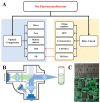A Highly Integrated and Diminutive Fluorescence Detector for Point-of-Care Testing: Dual Negative Feedback Light-Emitting Diode (LED) Drive and Photoelectric Processing Circuits Design and Implementation
- PMID: 36140149
- PMCID: PMC9496958
- DOI: 10.3390/bios12090764
A Highly Integrated and Diminutive Fluorescence Detector for Point-of-Care Testing: Dual Negative Feedback Light-Emitting Diode (LED) Drive and Photoelectric Processing Circuits Design and Implementation
Abstract
As an important detection tool in biochemistry, fluorescence detection has wide applications. Quantitative detection can be achieved by detecting fluorescence signals excited by excitation light at a specific wavelength range. Therefore, the key to fluorescence detection is the stable control of the excitation light and the accurate acquisition of weak photoelectric signals. Moreover, to improve portability and instantaneity, devices are developing in miniaturization and integration. As the core of such devices, fluorescence detectors should also have these features. Under this circumstance, we designed a highly integrated and diminutive fluorescence detector and focused on its excitation light driving and photoelectric signal processing. A current-light dual negative feedback light-emitting diode (LED) driving circuit was proposed to obtain constant current and luminance. In addition, a silicon photodiode (PD) was used to receive and convert the fluorescence signal to an electric signal. Then, amplifying, filtering, and analog-to-digital (A/D) converting were applied to make the detection of weak fluorescence signals possible. The test results showed that the designed circuit has wonderful performance, and the detector shows good linearity (R2 = 0.9967) and sensitivity (LOD = 0.077 nM) in the detection of fluorescein sodium solution. Finally, a real-time fluorescence polymerase chain reaction (real-time PCR) of Legionella pneumophila was carried out on a homemade platform equipped with this detector, indicating that the detector met the requirements of real-time PCR detection.
Keywords: LED drive circuit; fluorescence detection; photoelectric processing circuit; point-of-care testing; real-time fluorescence PCR.
Conflict of interest statement
The authors declare no conflict of interest.
Figures









Similar articles
-
A miniaturized and integrated dual-channel fluorescence module for multiplex real-time PCR in the portable nucleic acid detection system.Front Bioeng Biotechnol. 2022 Sep 12;10:996456. doi: 10.3389/fbioe.2022.996456. eCollection 2022. Front Bioeng Biotechnol. 2022. PMID: 36172017 Free PMC article.
-
A facile light-emitting-diode induced fluorescence detector coupled to an integrated microfluidic device for microchip electrophoresis.Talanta. 2011 May 30;84(4):1099-106. doi: 10.1016/j.talanta.2011.03.020. Epub 2011 Mar 16. Talanta. 2011. PMID: 21530784
-
A compact and highly sensitive light-emitting diode-induced fluorescence detector for capillary flow systems.Talanta. 2012 Jan 15;88:463-7. doi: 10.1016/j.talanta.2011.11.015. Epub 2011 Nov 9. Talanta. 2012. PMID: 22265527
-
A novel HPLC flow cell integrated UV light emitting diode induced fluorescence detector as alternative for sensitive determination of aflatoxins.Anal Chim Acta. 2018 Nov 29;1033:81-86. doi: 10.1016/j.aca.2018.06.059. Epub 2018 Jun 23. Anal Chim Acta. 2018. PMID: 30172335
-
Toward commercial applications of LED and laser-induced fluorescence techniques for food identity, quality, and safety monitoring: A review.Compr Rev Food Sci Food Saf. 2023 Sep;22(5):3620-3646. doi: 10.1111/1541-4337.13196. Epub 2023 Jul 17. Compr Rev Food Sci Food Saf. 2023. PMID: 37458292 Review.
Cited by
-
Photothermally Driven Ultrafast Polymerase Chain Reaction: Mechanisms, Nanomaterial Architectures, and System Integration.Research (Wash D C). 2025 Aug 15;8:0839. doi: 10.34133/research.0839. eCollection 2025. Research (Wash D C). 2025. PMID: 40822125 Free PMC article. Review.
-
A New Hematocrit Measurement Method Using a Chemiluminescence Biosensor and Its Application in a Chemiluminescence Immunoassay Platform for Myocardial Markers Detection with Whole Blood Samples.Biosensors (Basel). 2022 Dec 21;13(1):3. doi: 10.3390/bios13010003. Biosensors (Basel). 2022. PMID: 36671839 Free PMC article.
-
Fluorescence Multi-Detection Device Using a Lensless Matrix Addressable microLED Array.Biosensors (Basel). 2024 May 22;14(6):264. doi: 10.3390/bios14060264. Biosensors (Basel). 2024. PMID: 38920568 Free PMC article.
References
-
- Chen H., Wu Y., Chen Z., Mou X., Li Z., Su E., Deng Y., He N. From Sample to Answer: A Low-Cost Disposable Cartridge for Epidemic Detection on Site Based on 3D Printing Technology. Nanosci. Nanotechnol. Lett. 2016;8:1118–1126. doi: 10.1166/nnl.2016.2278. - DOI
MeSH terms
Substances
Grants and funding
LinkOut - more resources
Full Text Sources
Research Materials
Miscellaneous

